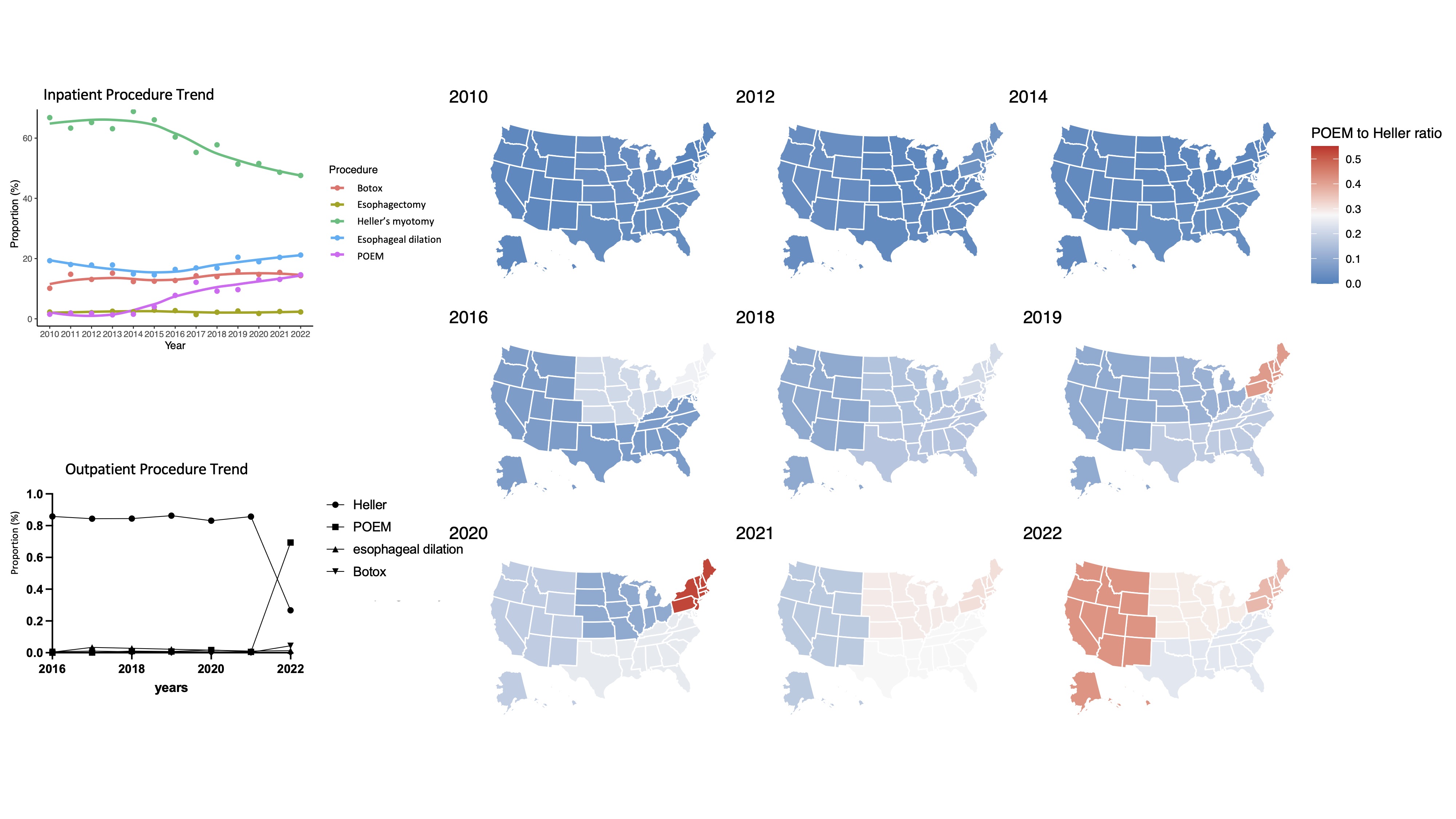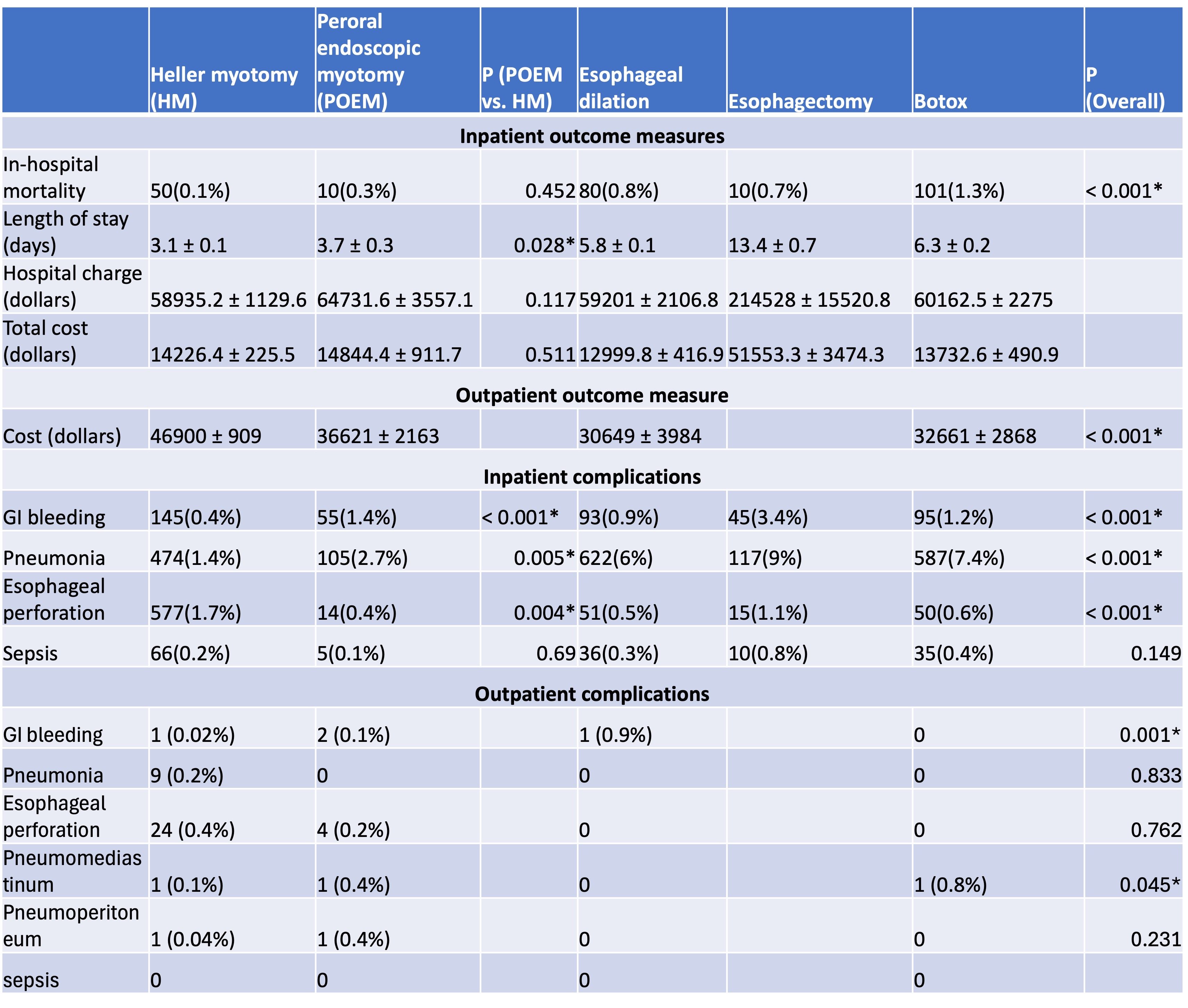Monday Poster Session
Category: Esophagus
P2804 - Paradigm Shift in the Treatment of Achalasia Since the Introduction of Peroral Endoscopic Myotomy
Monday, October 27, 2025
10:30 AM - 4:00 PM PDT
Location: Exhibit Hall
- CG
Changlin Gong, MD
NYC Health + Hospitals/Jacobi
Bronx, NY
Presenting Author(s)
Changlin Gong, MD1, Lingyu Bao, MD, PhD2, Yichen Wang, MD3, Brian E. Lacy, MD, PhD, FACG4
1NYC Health + Hospitals/Jacobi, Bronx, NY; 2Montefiore Medical Center, Albert Einstein College of Medicine, Bronx, NY; 3Hospital of the University of Pennsylvania, Philadelphia, PA; 4Mayo Clinic, Jacksonville, FL, US, Jacksonville, FL
Introduction: In the 2020 ACG achalasia guidelines, peroral endoscopic myotomy (POEM) was recommended as a therapy of comparable effectiveness to laparoscopic Heller myotomy (HM) and pneumatic dilation for type I and II achalasia, as well as the preferred therapy for type III achalasia. We conducted this study to analyze the trend and outcomes of procedures for achalasia since 2010.
Methods: Retrospective data were retrieved from the National Inpatient Sample (NIS) and Nationwide Ambulatory Surgery Sample (NASS) databases. Diagnoses and procedures were identified with Classification of Diseases (ICD) and Current Procedural Terminology (CPT) codes. All adult patients with a primary diagnosis of achalasia were included. Procedure trends as well as outcome measures including mortality, cost, and complications were analyzed.
Results: The data retrieved represented approximately 83,072 admissions and 8,978 office visits across the US. From 2010 to 2022, the proportion of patients who received POEM increased, while the proportion of those who received HM decreased; there was a significant increase in the POEM to HM ratio in the inpatient setting. Geographically, this ratio first increased in the Northeast, followed by the South and Midwest, and then the West. No significant differences were found in in-hospital mortality between POEM and HM. However, patients who received POEM had a longer hospital stay (3.7 vs 3.1 days, P = 0.028), higher risk of gastrointestinal bleeding (GIB, 1.4% vs 0.4%, P < 0.001) and pneumonia (2.7% vs 1.4%, P = 0.005), but a lower risk of esophageal perforation (0.4% vs 1.7%, P = 0.004). Trends for both decreasing length of stay and complications were found in POEM over the years.
In the outpatient setting, achalasia procedures, particularly POEM, increased sharply since 2022. In contrast to inpatients, patients treated with POEM in the outpatient setting have lower health care costs ($36,621 vs $46,900, p=0.00), with no difference in complications, including GI bleeding and perforation.
Discussion: Since 2010, there has been an increase in POEM across the US, first observed in the Northeast. Although POEM initially resulted in a slightly longer hospital stay, and increased risk for GIB and pneumonia compared to HM, there is a recent decreased trend in these complications which may reflect technology advancement and increased operator experience. POEM as an ambulatory procedure is associated with significantly lower healthcare costs with no complication differences compared to HM.

Figure: Trend of procedure performance over years and across regions

Figure: Procedure outcomes and complications
Disclosures:
Changlin Gong indicated no relevant financial relationships.
Lingyu Bao indicated no relevant financial relationships.
Yichen Wang indicated no relevant financial relationships.
Brian Lacy: AbbVie – Grant/Research Support. Ardelyx – Consultant. Gemelli Biotech – Consultant. GSK – Consultant. Ironwood Pharmaceuticals – Consultant, Grant/Research Support.
Changlin Gong, MD1, Lingyu Bao, MD, PhD2, Yichen Wang, MD3, Brian E. Lacy, MD, PhD, FACG4. P2804 - Paradigm Shift in the Treatment of Achalasia Since the Introduction of Peroral Endoscopic Myotomy, ACG 2025 Annual Scientific Meeting Abstracts. Phoenix, AZ: American College of Gastroenterology.
1NYC Health + Hospitals/Jacobi, Bronx, NY; 2Montefiore Medical Center, Albert Einstein College of Medicine, Bronx, NY; 3Hospital of the University of Pennsylvania, Philadelphia, PA; 4Mayo Clinic, Jacksonville, FL, US, Jacksonville, FL
Introduction: In the 2020 ACG achalasia guidelines, peroral endoscopic myotomy (POEM) was recommended as a therapy of comparable effectiveness to laparoscopic Heller myotomy (HM) and pneumatic dilation for type I and II achalasia, as well as the preferred therapy for type III achalasia. We conducted this study to analyze the trend and outcomes of procedures for achalasia since 2010.
Methods: Retrospective data were retrieved from the National Inpatient Sample (NIS) and Nationwide Ambulatory Surgery Sample (NASS) databases. Diagnoses and procedures were identified with Classification of Diseases (ICD) and Current Procedural Terminology (CPT) codes. All adult patients with a primary diagnosis of achalasia were included. Procedure trends as well as outcome measures including mortality, cost, and complications were analyzed.
Results: The data retrieved represented approximately 83,072 admissions and 8,978 office visits across the US. From 2010 to 2022, the proportion of patients who received POEM increased, while the proportion of those who received HM decreased; there was a significant increase in the POEM to HM ratio in the inpatient setting. Geographically, this ratio first increased in the Northeast, followed by the South and Midwest, and then the West. No significant differences were found in in-hospital mortality between POEM and HM. However, patients who received POEM had a longer hospital stay (3.7 vs 3.1 days, P = 0.028), higher risk of gastrointestinal bleeding (GIB, 1.4% vs 0.4%, P < 0.001) and pneumonia (2.7% vs 1.4%, P = 0.005), but a lower risk of esophageal perforation (0.4% vs 1.7%, P = 0.004). Trends for both decreasing length of stay and complications were found in POEM over the years.
In the outpatient setting, achalasia procedures, particularly POEM, increased sharply since 2022. In contrast to inpatients, patients treated with POEM in the outpatient setting have lower health care costs ($36,621 vs $46,900, p=0.00), with no difference in complications, including GI bleeding and perforation.
Discussion: Since 2010, there has been an increase in POEM across the US, first observed in the Northeast. Although POEM initially resulted in a slightly longer hospital stay, and increased risk for GIB and pneumonia compared to HM, there is a recent decreased trend in these complications which may reflect technology advancement and increased operator experience. POEM as an ambulatory procedure is associated with significantly lower healthcare costs with no complication differences compared to HM.

Figure: Trend of procedure performance over years and across regions

Figure: Procedure outcomes and complications
Disclosures:
Changlin Gong indicated no relevant financial relationships.
Lingyu Bao indicated no relevant financial relationships.
Yichen Wang indicated no relevant financial relationships.
Brian Lacy: AbbVie – Grant/Research Support. Ardelyx – Consultant. Gemelli Biotech – Consultant. GSK – Consultant. Ironwood Pharmaceuticals – Consultant, Grant/Research Support.
Changlin Gong, MD1, Lingyu Bao, MD, PhD2, Yichen Wang, MD3, Brian E. Lacy, MD, PhD, FACG4. P2804 - Paradigm Shift in the Treatment of Achalasia Since the Introduction of Peroral Endoscopic Myotomy, ACG 2025 Annual Scientific Meeting Abstracts. Phoenix, AZ: American College of Gastroenterology.
